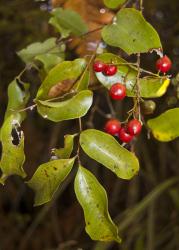- Taxon
- Gallery
- = Smilax ripogonum G.Forst., Fl. Ins. Austr. (1786)
- = Ripogonum parviflorum R.Br., Prodr. Fl. Nov. Holland. 293 (1810) nom. illeg.
Woody, evergreen liane of twining habit. Horizontal rhizome stout, often swollen into a woody tuber at base of erect stem. Stems of two kinds: (a) twining stems growing upward from mature rhizome on forest floor, without green lvs, succulent at tip; these are several m. long, c. 1.5–2 cm. diam., little branched, almost black, finely pubescent; nodes c. 10–20 cm. apart, thickened; sheathing scale leaves to several cm. long, alt. or opp., almost black, membr., brown-scabrid, caducous. (b) non-twining stems arising from the long stems in full light; these are to 1 m. long, c. 5 mm. diam., more branched and wide-spreading, light brown, glab.; internodes shorter, the distal ones bearing green lvs and infls. Green lvs mostly opp., 5.5–16 × 2–6 cm., ± coriac., narrow-ovate to oblong, narrowed rather abruptly to tip, margins entire and ± undulate; petiole c. 1 cm. long, ± channelled. Infl. axillary or terminal, simple or compound, to 15 cm. long; bracts us. all small and membr., but occ. some foliaceous. Pedicels c. 5–9 mm. long, without bracteole at base but with one or more adjacent to and resembling per.-segs. Fls not crowded. Tepals minute, free, spreading. Stamens much > tepals; filaments c. 2 mm. long; anthers greenish, linear-oblong, c. 3–5 × 1–1.5 mm., dehiscing laterally by long slits. Ovary globose, c. 1.5 mm. diam.; ovules 2 per locule, attached about mid-level; style 2 mm. long, including stigma of 3 verrucose lobes. Fr. globose, bright red, c. 1 cm. diam., the thin fleshy pericarp tightly stretched over 1–2–(3) hard, spotted seeds, seed when single almost spherical. Fr. falling, 12–15 months after fl., by abscission layer just above per. 2n = 30.
[From: Moore and Edgar (1970) Flora of New Zealand. Volume 2.]
Flowering: Dec.–Jan.; Fruiting: Jan.–Dec.




